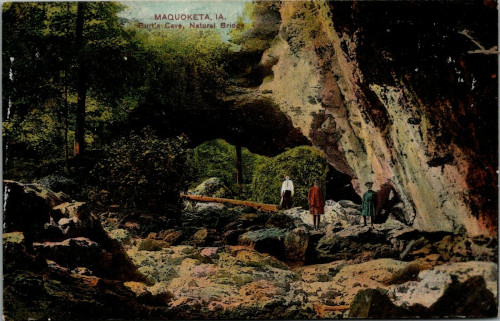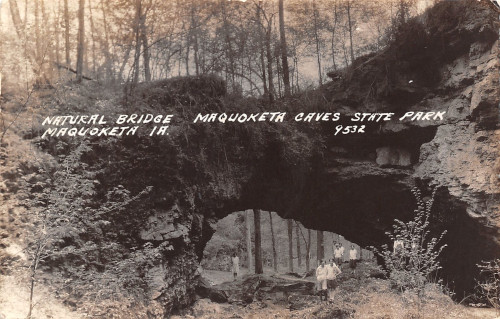
Maquoketa Caves
Caves Have Been Famous For Over Seventy Years
Local attraction first known as Burt's Caves; Dedicated in 1933
For more than 70 years the Maquoketa Caves has been a mecca for visitors who have come from far and near to view its natural wonders. Known first as Burt's Caves and later as Moorhead Caves, it was visited in the early days by many parties of young folk who came in "top buggies" from Davenport or Clinton on "Caves parties." The distance was so far and the means of travel so slow that these visitors were forced to remain overnight in Maquoketa, but nevertheless, such trips were a popular diversion.
That these great underground passages were, thousands of years ago, the homes of prehistoric people has been proven by the discovery of stone, flint, bone and horn artifacts which have from time to time been washed out by flood waters. In pioneer days they served as hiding places for the outlaws which infested the northern part of our county, particularly for horsethieves.
The discovery of these caves dates back a century ago when Jonathan Bear and David Scott were the first white men to visit this spot. The men, on a hunting trip, had started at sunset, up a ravine which led from the Maquoketa river and they had not proceeded far when they found the trail of deer. Pursuing the animals up the gorge they discovered that the ravine seemed to end abruptly in a rock wall, when suddenly the deer disappeared into a cave. Building a campfire in front of the cave to prevent the animals escape, the hunters prepared for the night. When dayligh appeared they discovered that there was an outlet at the other end of the cave, and the deer had escaped.
For 40 years the caves were on the Moorhead land until about 25 years ago when the site was purchased for a state park by the State Board of Conservation. In 1933 an additional section of land was purchased and the park was dedicated on October 13, 1933, Gov. Clyde L. Herring attending to accept it for the State of Iowa.
Features of the park are the natural bridge which would be wide enough for a roadway, the 17-ton balanced rock which rests on a space of a few inches, and the variety of trees, wild flowers, and ferns. New trails and similar improvements were erected by the CCC camp when it was located in Maquoketa, and a lodge is now under construction.
The dedication committee of 1933 which included the leaders in the movement for enlarging and improving the park, included Frank E. Ellis, as chairman; Edw. Luckiesh, J. H. Curtis, H. roy Sanner, George Anacker, Ralph McNerney, John Blessing, Mrs. Francis Bowen Myatt, George Francois, John Hullman, Eugene Mohr, Larry Guenther, Earl Boyer, Frank Purinton, Louise Maiolfi, Dr. and Mrs. D. N. Loose, and Mrs. Charles von Schrader.
These postcards of the caves are from the David Shedlock collection

Burt's Caves Postcard
Back of Postcard

Maquoketa Caves Postcard
SOURCE: Jackson Sentinal Centennial Edition - 1938